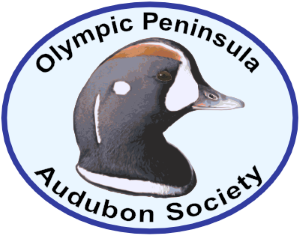Photo: Trumpeter Swans by Dee Renee Ericks
The Evans Road Trumpeter Swans
By John Acklen, OPAS Project Swan Safe Manager, with input from Shelly Ament WDFW
Just as we relax and enjoy watching the swans taking off and landing safely at Kirner Pond due to last summer’s power line burial project, we became aware of a new threat to recently returned Trumpeter Swans which overwinter here. The following account is extracted from “NextDoor”, a neighborhood chat application.
“Driving along Evans Road yesterday I was treated to a field of trumpeter swans. • • • As sundown came, they began to take wing. Disaster! One bird ran into the power lines stretching across the field; this caused a huge bang and power interruption. The magnificent bird plummeted to the field and within a few, very long moments, died.” Posted on NextDoor. Nov 24,
On 11/29, Shelly Ament, the Washington Department of Fish and Wildlife (WDFW) biologist, and I, met with the local landowner who farms along Evans Road. We met where we could observe swans gleaning corn from his harvested field. As we talked, we became painfully aware that light was fading and fog was beginning to blanket the field as approximately 45 swans begin to fly toward their evening roost. Some swans barely cleared the lines. Could the swans see the power lines in these conditions? Swans frequently move in low light and even after dark. They often fly off in flocks and we know from Kirner Pond observations that while the lead bird may clear the lines, following swans, flying slightly lower, may not to see the power lines and collide with them.
Foraging swans begin to leave the field. Photo by Shelly Ament.
The landowner told us that altogether, seven swans and four Canada Geese had died since the swans returned in mid-November. He did not report the dead birds nor collect carcasses initially. But he became concerned as mortalities increased. On 11/24 he contacted Shelly via WDFW. She quickly called the landowner to confirm information about the bird mortalities and promptly reported the power line collisions to the PUD. Shelly was able to confirm a total of three swan mortalities – one feather pile on 11/24 (report from NextDoor), one swan collected 11/24, and one swan collected 11/26. The two adult swan carcasses were taken to Greywolf Veterinary Hospital for an assessment and samples were taken for lead testing.
According to Mel Walters, Puget Sound Energy’s, avian protection plan manager, a spate of early season collision mortalities is not uncommon among swans. When swans first arrive back from their northern breeding grounds, they are not well oriented to their surroundings. They have to learn locations of the power lines. As they learn, mortalities become less common.
Shelly and I contacted PUD’s Engineering Manager, Mike Hill, to determine what could be done to mitigate the situation. Mike was well aware of the situation as PUD had responded to a number of outages along Evans Road. PUD acted quickly to begin to mitigate the situation. PUD shut off power to two of the three power lines along Evans Rd. Although this did not eliminate the collision risk, it does prevent electrocution when birds collide. Within a couple of days, PUD also took down and removed the power line across the field which will not be needed until next spring. This eliminated the single biggest threat to the swans.
Marking the remaining lines, however, posed engineering challenges for PUD. This is an old power line. The power poles and lines are actually scheduled for replacement next summer. The existing power lines are thin gauge copper and are very loose and brittle. The type of markers PUD used at Kirner Road could not be used here. Adding weight and dangling line markers could result in line slap and entanglement which is a threat to electrical service reliability. This is inconvenient but not necessarily harmful. But when electrical power comes back after an outage, it goes through a surge condition that can damage appliances and equipment.
The Evans Rd threat calls for a different marking solution. After researching and obtaining product samples, we and PUD hit upon a marker solution using a Power Line Sentry line marker that is shaped like a pup tent. The photoluminescent white strip glows in the dark for a full 24 hours and the fluorescent yellow strip serves as a mirror to reflect light. The shape lacks movement but is visible from all angles. The PUD crew scheduled to begin marking the lines the last week of December but an intense winter storm and the need to respond to massive power outages delayed their plans.
Proposed temporary line markers to be installed in winter of 2021-22
Photo credit https://powerlinesentry.com/products/distribution/
Line marking is an interim solution for this season. The landowner requested from the PUD a cost estimate for line burial. The cost may prove to be prohibitive for the landowner. PUD is scheduled to construct a new overhead line in summer of 2022. They also plan to mark the new line using markers in a pattern developed and refined by Puget Sound Energy for swans over a 30-year period. They’ll use a combination of spinning and flapping markers, which also glow in the dark. The marking pattern has proven to be effective and has been adopted by various northwest power companies dealing with swan issues in our area.
OPAS will continue to work with WDFW and Clallam County PUD to improve swan safety.

